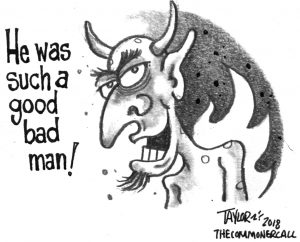History shows that when a Republican president is in serious legal trouble, Bill Barr is the go-to guy.
By Thom Hartmann
National Memo / Independent Media Institute (3/25/19)
Back in 1992, the last time Bill Barr was U.S. attorney general, iconic New York Timeswriter William Safire referred to him as “Coverup-General Barr” because of his role in burying evidence of then-President George H.W. Bush’s involvement in “Iraqgate” and “Iron-Contra.”
General Barr has struck again—this time, in similar fashion, burying Mueller’s report and cherry-picking fragments of sentences from it to justify Trump’s behavior. In his letter, he notes that Robert Mueller “leaves it to the attorney general to decide whether the conduct described in the report constitutes a crime.”
As attorney general, Barr—without showing us even a single complete sentence from the Mueller report—decided there are no crimes here. Just keep moving along.
Barr’s history of doing just this sort of thing to help Republican presidents in legal crises explains why Trump brought him back in to head the Justice Department.
Christmas day of 1992, the New York Times featured a screaming all-caps headline across the top of its front page: Attorney General Bill Barr had covered up evidence of crimes by Reagan and Bush in the Iran-Contra scandal.
Earlier that week of Christmas, 1992, George H.W. Bush was on his way out of office. Bill Clinton had won the White House the month before, and in a few weeks would be sworn in as president.
But Bush’s biggest concern wasn’t that he’d have to leave the White House to retire back to Connecticut, Maine, or Texas (where he had homes) but, rather, that he may end up embroiled even deeper in Iran-Contra and that his colleagues may face time in a federal prison after he left office.
Independent Counsel Lawrence Walsh was closing in fast on him, and Bush’s private records, subpoenaed by the independent counsel’s office, were the key to it all.

A tribute to George H.W. Bush.
Barr successfully covered up the involvement of two Republican presidents—Reagan and Bush—in two separate and perhaps impeachable “high crimes. …Now, by cherry-picking Mueller’s report and handing Trump the talking points he needed, Barr has done it again.
Walsh had been appointed independent counsel in 1986 to investigate the Iran-Contra activities of the Reagan administration and determine if crimes had been committed.
What was George H.W. Bush’s role?
Was the Iran-Contra criminal conspiracy limited, as Reagan and Bush insisted (and Reagan confessed on TV), to later years in the Reagan presidency, in response to a hostage-taking in Lebanon? Or had it started in the 1980 campaign with collusion with the Iranians, as the then-president of Iran asserted? Who knew what, and when? And what was George H.W. Bush’s role in it all?
Walsh had zeroed in on documents that were in the possession of Reagan’s former defense secretary, Caspar Weinberger, who all the evidence showed was definitely in on the deal, and President Bush’s diary that could corroborate it. Elliott Abrams had already been convicted of withholding evidence from Congress, and he may have even more information, too, if it could be pried out of him before he went to prison. But Abrams was keeping mum, apparently anticipating a pardon.
Weinberger, trying to avoid jail himself, was preparing to testify that Bush knew about it and even participated, and Walsh had already, based on information he’d obtained from the investigation into Weinberger, demanded that Bush turn over his diary from the campaign. He was also again hot on the trail of Abrams.
So Bush called in his attorney general, Bill Barr, and asked his advice.
Barr, along with Bush, was already up to his eyeballs in cover-ups of shady behavior by the Reagan administration.
“Coverup-General”
Safire ultimately came refer to Barr as “Coverup-General” in the midst of another scandal—one having to do with Bush selling weapons of mass destruction to Saddam Hussein—as the Attorney General was already covering up for Bush, Weinberger, and others from the Reagan administration.
On October 19, 1992, Safire wrote of Barr’s unwillingness to appoint an independent counsel to look into Iraqgate:
“Why does the Coverup-General resist independent investigation? Because he knows where it may lead: to Dick Thornburgh, James Baker, Clayton Yeutter, Brent Scowcroft and himself [the people who organized the sale of WMD to Saddam]. He vainly hopes to be able to head it off, or at least be able to use the threat of firing to negotiate a deal.”
Now, just short of two months later, Bush was asking Barr for advice on how to avoid another very serious charge in the Iran-Contra crimes. How, he wanted to know, could they shut down Walsh’s investigation before Walsh’s lawyers got their hands on Bush’s diary?
In April of 2001, safely distant from the swirl of D.C. politics, the University of Virginia’s Miller Center was compiling oral presidential histories, and interviewed Barrabout his time as AG in the Bush White House. They brought up the issue of the Weinberger pardon, which put an end to the Iran-Contra investigation, and Barr’s involvement in it.
Up to their necks
Turns out, Barr was right in the middle of it.
“There were some people arguing just for [a pardon for] Weinberger, and I said, ‘No, in for a penny, in for a pound,’” Barr told the interviewer. “I went over and told the President I thought he should not only pardon Caspar Weinberger, but while he was at it, he should pardon about five others.”
Which is exactly what Bush did, on Christmas Eve when most Americans were with family instead of watching the news. The holiday notwithstanding, the result was explosive.
America knew that both Reagan and Bush were up to their necks in Iran-Contra, and Democrats had been talking about impeachment or worse. The independent counsel had already obtained one conviction, three guilty pleas, and two other individuals were lined up for prosecution. And Walsh was closing in fast on Bush himself. …
(Commoner Call cartoon by Mark L. Taylor, 2018. Open source and free for non-derivative use with link to wwwthecommonercall.org )


